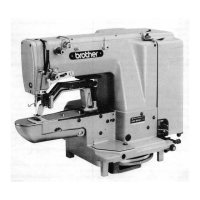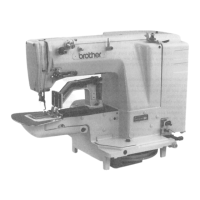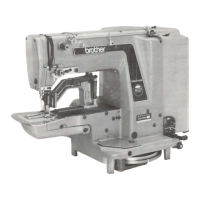What to do if needle is bent on Brother LK3-B432E MKII?
- SStefanie WilsonAug 16, 2025
If the needle on your Brother Sewing Machine is bent, you should replace it.

What to do if needle is bent on Brother LK3-B432E MKII?
If the needle on your Brother Sewing Machine is bent, you should replace it.
What to do if work clamp does not close on Brother Sewing Machine?
If the work clamp on your Brother Sewing Machine does not close, adjust the position of the presser closing roller.
Why doesn't the presser drop on my Brother LK3-B432E MKII Sewing Machine?
If the presser does not drop on your Brother Sewing Machine, hook the link return spring properly, as the presser lifter link is not moving back.
Why does the lower thread wind to one side on Brother LK3-B432E MKII Sewing Machine?
If the lower thread winds to one side on your Brother Sewing Machine, adjust the height of the thread tension stud, because the bobbin winder thread tension stud height is incorrect.
What to do if presser does not rise on Brother LK3-B432E MKII?
If the presser does not rise on your Brother Sewing Machine, grease the presser plate and presser arm lever support because there is too much friction between presser plate and presser arm lever support.
What to do if presser is contacting thread wiper on Brother LK3-B432E MKII?
If the presser is contacting the thread wiper on your Brother Sewing Machine, adjust the position of the thread wiper.
How to fix sluggish work clamp on Brother LK3-B432E MKII?
If the sliding part of the work clamp operation is sluggish on your Brother Sewing Machine, grease the sliding part of the work clamp.
How to adjust presser lifter amount on Brother LK3-B432E MKII?
To fix the issue where the distance between the presser lifter amount is too great on your Brother Sewing Machine, adjust the height of the work clamp to within 17 mm.
What to do if thread is too thick for the needle on Brother LK3-B432E MKII Sewing Machine?
If the thread you are using is too thick for the needle on your Brother Sewing Machine, use the correct thread for the needle.
How to fix upper thread if it is too short on Brother LK3-B432E MKII Sewing Machine?
To address the issue of the upper thread being too short on your Brother Sewing Machine, adjust the thread take-up lever stroke.
| Brand | Brother |
|---|---|
| Model | LK3-B432E MKII |
| Category | Sewing Machine |
| Language | English |
Explains safety indications and symbols used in the manual for safe operation.
Provides important safety precautions and guidelines for machine operation and environment.
Details technical specifications of the sewing machine models, including speed and dimensions.
Lists available sewing patterns with their stitch counts and dimensions for different materials.
Instructions for setting up the power table for the sewing machine, including dimensions.
Step-by-step guide for installing the machine's motor onto the work table.
Details on how to install the main control box and its components.
Guidance on mounting the sewing machine head onto the table assembly.
Procedures for connecting various electrical cords to the machine's internal components.
Instructions for fitting and adjusting the tension of the V-belt.
Steps for attaching and connecting the foot switch to the machine.
Guidance on installing the safety eye guard as a protective device.
Explains the purpose and function of each control on the operation panel.
Outlines the step-by-step process for operating the sewing machine, including pattern selection.
Guidance on choosing appropriate needles and threads for different materials.
Step-by-step instructions for safely installing a sewing needle.
Detailed procedure for threading the upper thread correctly through the machine.
Instructions for winding thread onto the bobbin for the lower thread.
Guide to replacing the bobbin case and threading the lower thread correctly.
Recommended settings for thread tension and sewing conditions for various materials.
Procedure for cleaning the machine's rotary hook to ensure proper function.
Details on lubrication points and schedule for maintaining the machine's moving parts.
How to adjust the vertical position of the needle bar for optimal sewing.
Procedure to set the correct needle bar lift for hook timing.
Steps for adjusting the needle guard to prevent thread breakage.
Adjusting the thread guide for smooth thread path and preventing issues.
Adjusting thread take-up lever stroke for sewing conditions.
Setting the correct lift height for the work clamp.
Adjusting how the work clamp closes for specific models.
Setting the position where the needle stops during operation.
Verifying sensor and DIP switch settings for machine functions and operation.
Procedure to check the machine's input voltage for proper operation.
How to reset all stored settings, programs, and memory.
How to reposition stitch patterns within the sewing area for custom layouts.
Using the counter to track bobbin thread usage and prevent interruptions.
Monitoring the total number of items sewn for production tracking.
Explains how to change machine functions using DIP switches on the operation panel.
Configuring presser foot behavior based on pedal input for different operations.
Guide to saving and recalling custom sewing settings and patterns.
Programming patterns for sequential, automated sewing operations.












